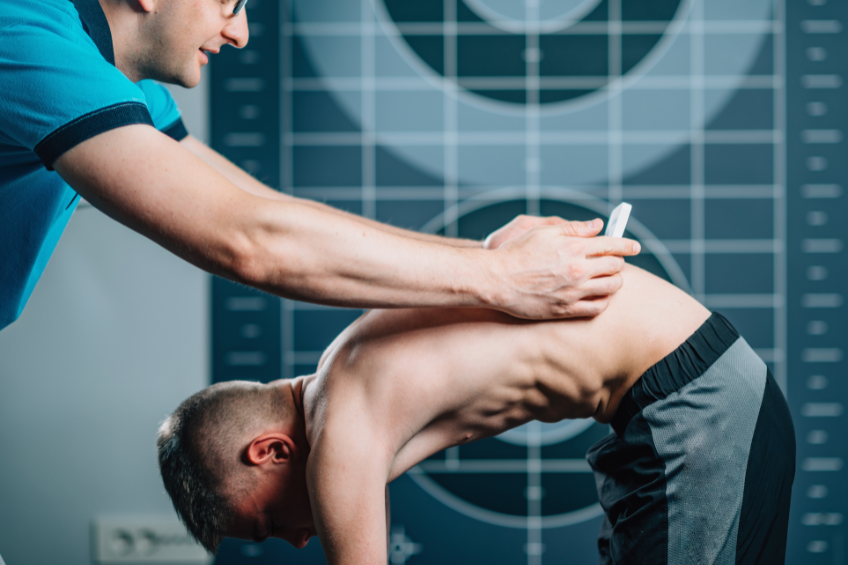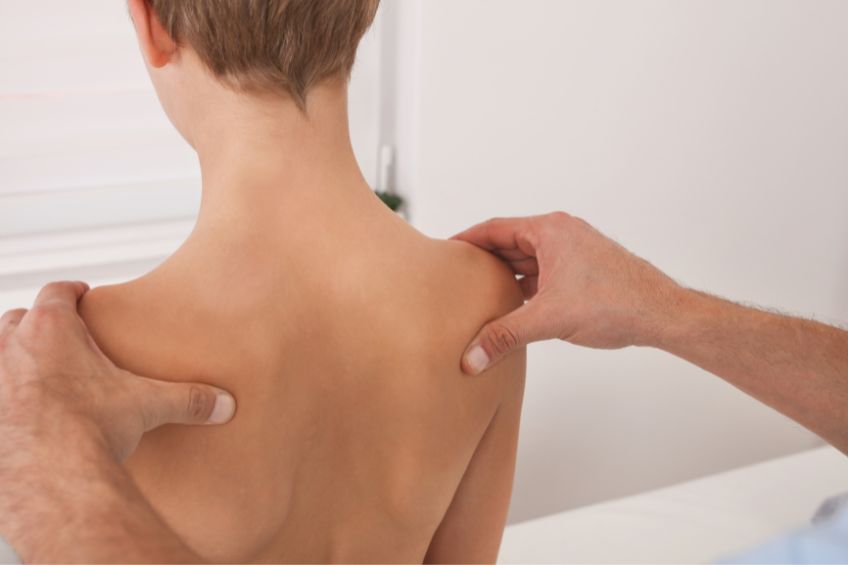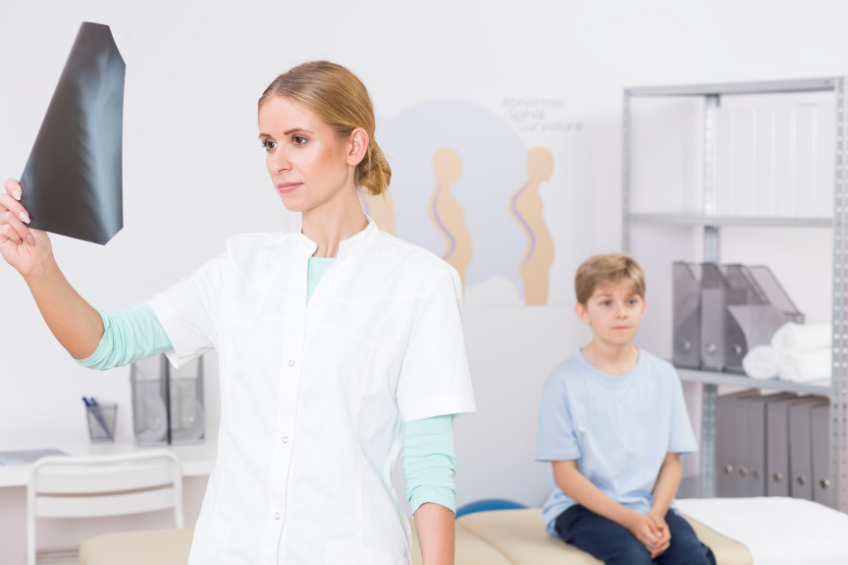Scoliosis In Teenage Boys
Allison was surprised to see a teenage boy entering the building where the offices for scoliosis therapy are located. She was taking her daughter, Heather, to check on the progress of her scoliosis Cobb curve since her daughter was under the care of the center and wearing a brace for several months. Allison was under the illusion that only girls suffered from scoliosis and boys did not have this problem and now she just learned something new about scoliosis, that it can affect boys too.

Statistics vary, but about 75% of the cases of idiopathic scoliosis are girls and is noticed around eleven to twelve years of age depending on puberty arrival. While it is true that girls are definitely in the majority when it comes to scoliosis, boys do get it but usually at a later age since their puberty begins later. An average of three to four percent of teenagers will require treatment for juvenile scoliosis and this condition must be caught early to be effectively treated.
While girls reach puberty fast, boys are much slower, and this is the reason why scoliosis in girls is generally more severe. Scoliosis occurs when the growth of the vertebrae in the back become wedged which causes curvature of the spine and places uneven load on the vertebrae which leads to further uneven growth of the spine. Tension on the spinal cord develops as the person bends.
Until recently boys wore looser clothing than girls making it more difficult to notice if the boy had any back curvature issues. Adding to that was the fact that scoliosis screening in schools does not always include the boys and the curvature forms much slower and parents may miss the signs of scoliosis. There is a greater range of years that a boy’s scoliosis can be diagnosed because many boys grow into their late teens as opposed to the girls whose growth is completed in a much shorter time span. Yet there are many cases where boys do have curves that require either bracing or surgery.
It is prudent that teenage males be screened at school or least at their regular doctor visit. The average age for guys is between thirteen and fourteen but if the individual is a late bloomer meaning late beginning puberty, the guy should be checked during his teen years until growing is complete. Although it is not always true, if the guy has a sibling or parent with scoliosis the chances due increase for him.
The proper way to inspect if the posture of the guy is correct is by doing a three-step check.
1) Check if the shoulders are even and the head centered.
2) Check if the opposite sides of the body are even.
3) Check the back muscles while the boy bends forward and see if there is a large difference in the opposite sides of the body. (By the way, make sure the guy removes his shirt.)
Here are two real-life case scenarios of scoliosis in teen males. Names have been changed to respect patients’ privacy.
Case #1: Clark Stephenson, 16, Cobb Rating: 55 Degrees
Clark’s parents had no idea that he was suffering from scoliosis even though there were some indicators that something was not right with his back. For example, he did complain about his back hurting, and he had his last checkup eighteen months previously because of Covid. Prior to that crazy time his parents were always on top of his checkups. The Covid period was the time that Clark experienced a big growth spurt and at the latest checkup when his doctor checked his spine, she became alarmed and sent him for X-rays. The checkup was on Friday and the X-rays were done that same day. By Monday morning Clark’s mom’s phone was ringing off the hook but she could not answer right away since she was at work. The doctor had already made Clark an appointment at a specialist causing his mom to freak out with worry. What could possibly be such an emergency? Mom felt so guilty when she saw the X-rays and felt it was her fault since, she missed one checkup and Clark had complained about his back and she had not taken it seriously.

Of course, Clark’s mom was not to blame. COVID-19 basically closed off doctors to their patients except for emergencies and Clark’s back pain was not that intense for his mom to advise him to see his doctor. Most children could postpone a doctor checkup for half a year with little consequences, but the problem with boys’ scoliosis is that it is not expected like girls. Also, it is also slower to develop and in some instances is not that severe when caught. However, this unfortunately was not the case with Clark since by the time his curvature was caught, he was not a candidate for bracing since he was too old and almost finished growing.
Therefore, the only way to correct Clark’s scoliosis was with surgery, even though the surgeon that they consulted advised physical therapy for scoliosis and a return visit in four months. Clark took the PT seriously, but his back pain was getting worse, and he was finding it quite difficult to sit or stand for long periods. In only four months Clark’s curve had increased from 49-50 degrees to 54-55 degrees and the doctor advised surgery.
Clark’s surgery sounded complicated with not only the shaving of some of his vertebrae and putting in steel rods, but they used the ground up bone powder for bone grafting. When the rods were screwed to his vertebrae the vertebrae themselves were grafted together. All this fusing would get the back straighter but unfortunately Clark would lose mobility of his spine.
Clark’s operation was called a success, his back is straighter, the back pain gone, and he is now able to sit for long periods of time. Clark’s height also increased by an inch which was good since he was in the lower height percentile for his age before the surgery. The only disadvantage is the mobility of his back for bending and other activities. His surgery was mandatory only because his scoliosis was not caught fast enough and if it would have been caught earlier a brace would have helped him.
Case #2: Amada Hurley’s son, 15, Cobb Rating: N/A
Scoliosis has been in Amanda’s family for generations but like Clark’s mom, Amanda was in shock when the doctor informed her that her son suffered from scoliosis. At the conclusion of her son’s annual checkup the doctor called her into the room, “See that, ”asked the doctor, “your son’s ribs are slightly higher on the right side of his back than on the left.”
Amanda was terrified because as a child she experienced spinal fusion surgery that took over eight hours after bracing did not solve the scoliosis. Her surgery was like Clark’s with the rods, fusion, and bone grafting. Post-surgery found Amanda in the hospital for a week and flat on the couch for six more weeks! This was not going to happen to her son, no way. Amanda’s brace that she wore prior to surgery was extremely uncomfortable and she has terrible memories of wearing it and on top of that she still required extensive surgery.

Today’s braces are much more comfortable but the trauma of Amanda’s experience with bracing and surgery made her very determined that her son would suffer with neither. Medicine has come a long way in the thirty years since those horrid times and Amanda was determined to discover a more comfortable option for her teenage son. “If people can straighten their teeth with plastic instead of metal (Invisalign) then there should be some similar type of bracing for crooked spines”.
The Whisper is so new that only forty patients have tried it. It was invented at a startup company called Green Sun Medical which it describes on its website, “a revolution in bracing technology”. With this type of open frame brace, patients can touch their toes while wearing it and there’s less area to cause pinching a chafing of the skin. Since it is made of hoops and rings, air can circulate around them. Adjustments can be made regularly during follow-up visits and since the components are modular and can be changed as necessary.
Final Words
It is most important that boys just as girls be checked often for symptoms of scoliosis. Although boys mature at a slower rate than girls and begin puberty later, they still can develop severe scoliosis. Many times, boys’ symptoms go unnoticed or ignored because the incidence is much less in males than females. As we can learn from the above cases, the severity can be enough to warrant surgery when the scoliosis is not diagnosed early enough.
The mother in the second scenario was so traumatized by her own scoliosis thirty years before that she would not allow her son to be fitted with today’s braces. All she could think about was the anguish and suffering that she went through wearing a metal brace. We hope the new whisper brace does the trick for Amanda’s son, but she failed to check out the present types of scoliosis braces that are available today at respected scoliosis centers. So, yes, Allison, teen guys do get scoliosis.


